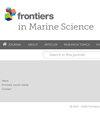基于改进蚁群算法的南极海冰分布检测
IF 3
2区 生物学
Q1 MARINE & FRESHWATER BIOLOGY
引用次数: 0
摘要
南极海冰面积的变化与大气和海洋的变化直接相关。确定南极海冰分布对全球气候变化分析具有重要意义。蚁群算法采用正反馈机制,不断收敛搜索过程,最终逼近最优解,便于找到检测海冰分布的最优分割阈值。然而,蚁群算法存在计算量大、易陷入局部最优的问题。为了更好地将蚁群算法应用到海冰分布检测中,提出了一种改进的蚁群算法,改进了蚁群算法中初始聚类中心的选择和信息素挥发因子的更新。将改进的蚁群算法与迭代算法、最大熵算法和基本全局阈值算法进行了比较,结果表明该算法是可行的。为了进一步验证改进蚁群算法的准确性,我们将MODIS数据与改进蚁群算法、迭代算法、最大熵算法和基本全局阈值算法的海冰检测结果进行了比较,结果表明,所提算法的准确率分别比其他三种算法高4.99%、3.66%和5.46%。本文章由计算机程序翻译,如有差异,请以英文原文为准。
Antarctic Sea ice distribution detection based on improved ant colony algorithm
The changes in the Antarctic sea ice area are directly related to the changes in the atmosphere and oceans. Determining the Antarctic sea ice distribution is of great significance to the global climate change analysis. The ant colony algorithm adopts a positive feedback mechanism to continuously converge the search process and ultimately approaches the optimal solution, making it easy to find the optimal segmentation threshold for detecting the sea ice distribution. However, the ant colony algorithm has the problems of high computational complexity and easy getting stuck in local optima. In order to better apply the ant colony algorithm to sea ice distribution detection, an improved ant colony algorithm was proposed, which improves the selection of initial clustering centers and the update of pheromone volatilization factors in the ant colony algorithm. We compared the improved ant colony algorithm with iterative algorithm, maximum entropy algorithm, and basic global threshold algorithm, and the results showed that the proposed algorithm is feasible. To further validate the accuracy of the improved ant colony algorithm, we compared the results obtained from MODIS data with the improved ant colony algorithm, iterative algorithm, maximum entropy algorithm, and basic global threshold algorithm for sea ice detection, and the results showed that the accuracy of the proposed algorithm was 4.99%, 3.66%, and 5.46% higher than the other three algorithms, respectively.
求助全文
通过发布文献求助,成功后即可免费获取论文全文。
去求助
来源期刊

Frontiers in Marine Science
Agricultural and Biological Sciences-Aquatic Science
CiteScore
5.10
自引率
16.20%
发文量
2443
审稿时长
14 weeks
期刊介绍:
Frontiers in Marine Science publishes rigorously peer-reviewed research that advances our understanding of all aspects of the environment, biology, ecosystem functioning and human interactions with the oceans. Field Chief Editor Carlos M. Duarte at King Abdullah University of Science and Technology Thuwal is supported by an outstanding Editorial Board of international researchers. This multidisciplinary open-access journal is at the forefront of disseminating and communicating scientific knowledge and impactful discoveries to researchers, academics, policy makers and the public worldwide.
With the human population predicted to reach 9 billion people by 2050, it is clear that traditional land resources will not suffice to meet the demand for food or energy, required to support high-quality livelihoods. As a result, the oceans are emerging as a source of untapped assets, with new innovative industries, such as aquaculture, marine biotechnology, marine energy and deep-sea mining growing rapidly under a new era characterized by rapid growth of a blue, ocean-based economy. The sustainability of the blue economy is closely dependent on our knowledge about how to mitigate the impacts of the multiple pressures on the ocean ecosystem associated with the increased scale and diversification of industry operations in the ocean and global human pressures on the environment. Therefore, Frontiers in Marine Science particularly welcomes the communication of research outcomes addressing ocean-based solutions for the emerging challenges, including improved forecasting and observational capacities, understanding biodiversity and ecosystem problems, locally and globally, effective management strategies to maintain ocean health, and an improved capacity to sustainably derive resources from the oceans.
 求助内容:
求助内容: 应助结果提醒方式:
应助结果提醒方式:


